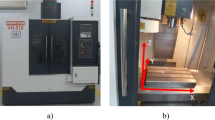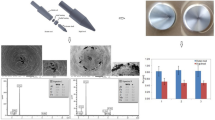Abstract
Surface roughness affects the performance and service life of the formed components. To this end, efforts have been spent in the innovative incremental sheet forming (ISF) process. However, the researchers yet have not reached any agreement regarding the process effects on roughness. This demands further research to comprehend the knowledge in order to acquire a threshold level of understanding on surface roughening in the process. The present study investigates the processing effects upon the roughness of interior surfaces and on the friction indicator at the tool/sheet interface during forming of an aluminum sheet. Some of the sparsely studied parameters, namely flow stress, sheet thickness, and forming angle, are undertaken besides commonly considered ones (i.e., tool diameter and step size). The analysis of the results reveals that the friction indicator and roughness are analogous in respect of their response to parameter variations. Further, the roughness in general linearly increases with an increase in the friction indicator because the sheet abrasion correspondingly increases as revealed by the SEM-based surface morphology. A combination of parameters, among several attempted ones, namely dsinθ/2pt (where d is the tool diameter, θ is the forming angle, p is the step size, and t is the sheet thickness), is identified to have controlling influence on the roughness of interior surfaces. This combination is validated employing two materials namely Al1060 and Cu/Steel composite. In this combination, the factor d/2p followed by 1/t is found to have the greatest contribution towards the roughening of surfaces. Moreover, the value of this combination is proposed to keep low in order to produce components with good finish, say ≤ 50 mm−1 for Al10160 and 20 mm−1 for Cu/Steel composite. The present and past roughness studies in ISF are also compared, which reveals that the parameters effects are associated to the type of material.
Similar content being viewed by others
References
Powell N, Andrew C (1992) Incremental forming of flanged sheet metal components without dedicated dies. Proc IMechE B J Eng Manuf 206:41–47
Jeswiet J, Hagan E (2001) Rapid proto-typing of a headlight with sheet metal. Proceedings of Shemet Conference 165–170
Ambrogio G, Filice L, Gagliardi F (2012) Improving industrial suitability of incremental sheet forming process. Int J Adv Manuf Technol 58:941–947
Li J, Bai T, Zhou Z (2014) Numerical simulation and experimental investigation of incremental sheet forming with an elastic support. Int J Adv Manuf Technol 74:1649–1654
Fan G, Gao L, Hussain G, Wu Z (2008) Electric hot incremental forming: a novel technique. Int J Mach Tools Manuf 48:1688–1692
Duflou JR, Callebaut B, Verbert J, Baerdemaeker HD (2008) Improved SPIF performance through dynamic local heating. Int J Mach Tools Manuf 48:543–549
Echrif SBM, Hrairi M (2011) Research and progress in incremental sheet forming processes. Mater Manuf Process 26:1404–1414
Jeswiet J, Micari F, Hirt G, Bramley A, Duflou J, Allwood J (2005) Asymmetric single point incremental forming of sheet metal. Ann CIRP 54:623–650
Gatea S, Ou H, McCartney G (2016) Review on the influence of process parameters in incremental sheet forming. Int J Adv Manuf Technol 87:479–499
Kim YH, Park JJ (2002) Effect of process parameters on formability in incremental forming of sheet metal. J Mater Process Technol 130/131:42–46
Hussain G, Gao L, Hayat N, Cui Z, Pang Y, Dar NU (2008) Tool and lubrication for negative incremental forming of a commercially pure titanium sheet. J Mater Process Technol 203:193–201
Lu B, Fang Y, Xua DK, Chen J, Oub H, Moser MH, Cao J (2014) Mechanism investigation of friction-related effects in single point incremental forming using a developed oblique roller-ball tool. Int J Mach Tools Manuf 85:14–29
Hussain G, Gao L, Zhang ZY (2008) Formability evaluation of the pure titanium sheet in the cold incremental forming process. Int J Adv Manuf Technol 37:920–926
Lu B, Chen J, Ou H, Cao J (2013) Feature-based tool path generation approach for incremental sheet forming process. J Mater Process Technol 213:1221–1233
Hagan E, Jeswiet J (2004) Analysis of surface roughness for parts formed by computer numerical controlled incremental forming. Proc IMechE J Eng Manuf 218:1307–1312
Echrif SBM, Hrairi M (2014) Significant parameters for the surface roughness in incremental forming process. Mater Manuf Process 29:697–703
Durante M, Formisano A, Langella A (2011) Observations on the influence of tool-sheet contact conditions on an incremental forming process. J Mater Eng Perform 20:941–946
Mugendiran V, Babu AG, Ramadoss R (2000) Parameter optimization for surface roughness and wall thickness on AA5052 aluminium alloy by incremental forming using response surface methodology. Process Eng 97:1991–2000
Cavaler LCC, Schaeffer L, Rocha AS, Peruch F (2010) Surface roughness in the incremental forming of AISI 304L stainless steel sheets. Far East J Mech Eng Ph 1:87–98
Baruah A, Pandivelan C, Jeevanantham AK (2017) Optimization of AA5052 in incremental sheet forming using grey relational analysis. Measurement 106:95–100
Durante M, Formisano A, Langella A, Memola F, Minutolo C (2009) The influence of tool rotation on an incremental forming process. J Mater Process Technol 209:4621–4626
Xu D, Wu W, Malhotra R, Chen J, Lu B, Cao J (2013) Mechanism investigation for the influence of tool rotation and laser surface texturing (LST) on formability in single point incremental forming. Int J Mach Tools Manuf 73:37–46
Hamilton K, Jeswiet J (2010) Single point incremental forming at high feed rates and rotational speeds: surface and structural consequences. CIRP Ann—Manuf Technol 59:311–314
Montgomery DC (1997) Design and analysis of experiments, 4th edn. Wiley, New York
ASTM Book of Standards Volume 03.01 (2018) Metals—mechanical testing; elevated and low-temperature tests; Metallography
Al-Ghamdi KA, Hussain G (2015) Forming forces in incremental forming of a geometry with corner feature: investigation into the effect of forming parameters using response surface approach. Int J Adv Manuf Technol 76:2185–2197
Shi X, Hussain G, Butt Shahid I, Song F, Huang D, Liu Y (2017) The state of residual stresses in the Cu/steel bonded laminates after ISF deformation: an experimental analysis. J Manuf Process 30:14–26
Azushima A, Sakuramoto M (2006) Effects of plastic strain on surface roughness and coefficient of friction in tension-bending test. Ann CIRP 55:303–306
Funding
This research work was supported by the Fundamental Research Funds for the Central Universities (Grant No.: NS2015054) PR China and State Administration of Foreign Experts Affairs PR China and Ministry of Education PR China (111 project, Grant No.: B16024).
Author information
Authors and Affiliations
Corresponding author
Rights and permissions
About this article
Cite this article
Wei, H., Hussain, G., Iqbal, A. et al. Surface roughness as the function of friction indicator and an important parameters-combination having controlling influence on the roughness: recent results in incremental forming. Int J Adv Manuf Technol 101, 2533–2545 (2019). https://doi.org/10.1007/s00170-018-3096-1
Received:
Accepted:
Published:
Issue Date:
DOI: https://doi.org/10.1007/s00170-018-3096-1




